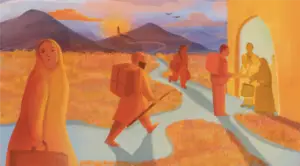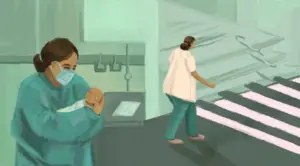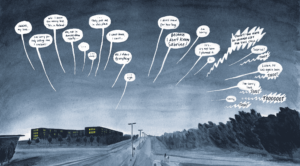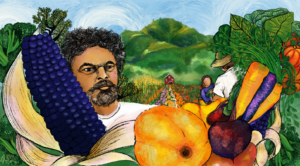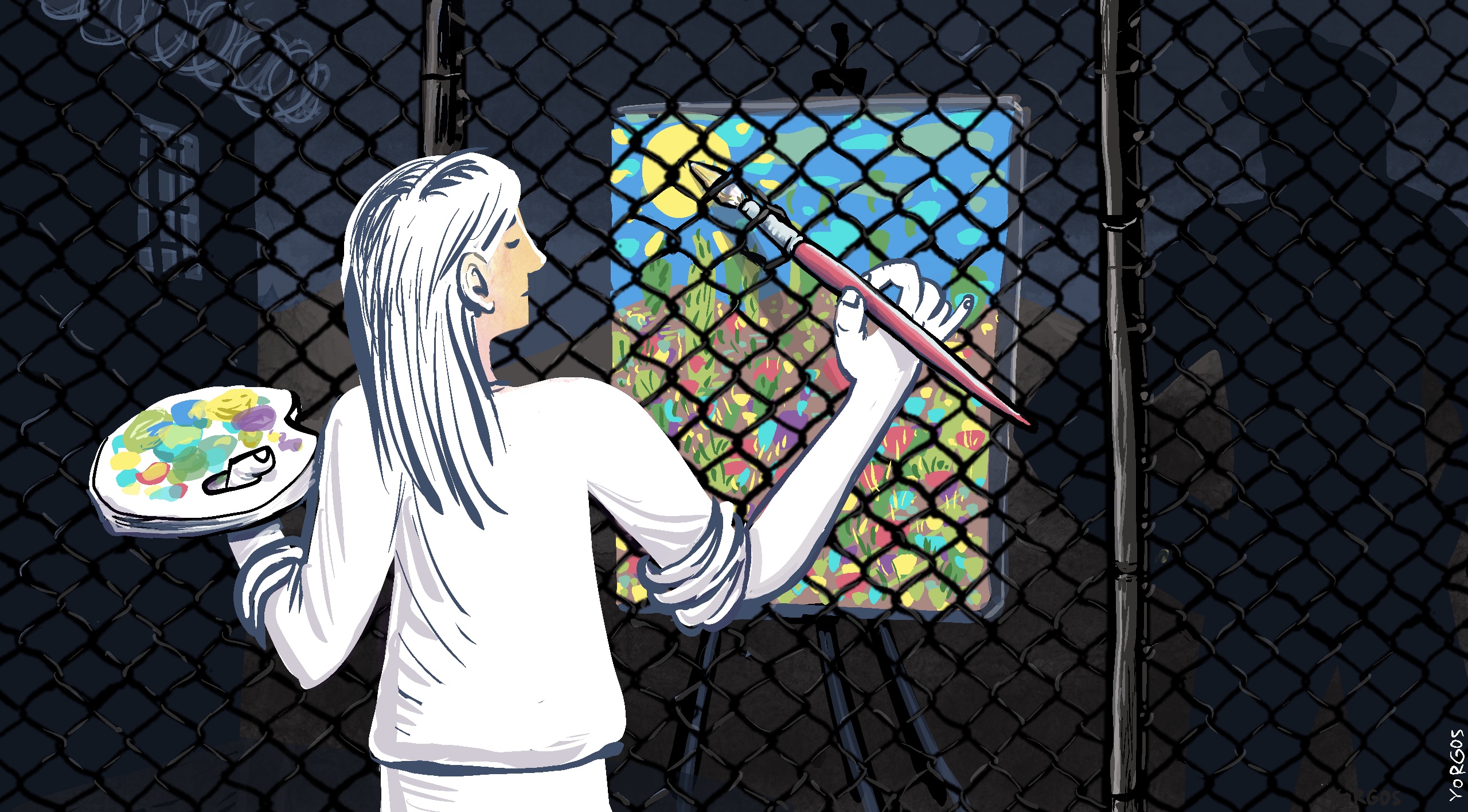
Detained Davincis: Artists in Lithuania draw attention to the plight of asylum-seekers
How a civil society organization connected with artists caught up in Lithuania's unlawful immigrant detention policy.
- Written and photographed by Gabriela Ramirez
- Edited by Tina Lee
- Illustration by Yorgos Konstantinou
In May 2021, several thousand people crossed from Belarus into Lithuania, seeking asylum in the European Union. One year later, most remain in detention, unable to make their case to authorities. But some have found a way to connect to the outside through their art.
“I have seen her paintings and drawings… like Leonardo da Vinci,” says one of the security guards while he checks my personal belongings. We are inside a bright blue shipping container about 6 m long by 2.44 m wide in Medininkai, a Lithuanian city bordering Belarus and home to one of five refugee camps across the country where nearly 4.000 people have been detained in precarious conditions since last summer.
He’s talking about Anna*, a woman I am here to visit.
Like the famed Renaissance artist, the human body is incorporated into many of her paintings, but unlike Da Vinci, Anna’s artwork is filled with bright colors and shows women surrounded by flowers and natural scenery.
Another difference between Anna and Da Vinci is that Anna does not use a wooden easel but rather the barbed-wire fence that borders the refugee camp where she has lived for the last 11 months as the primary support for her canvas.
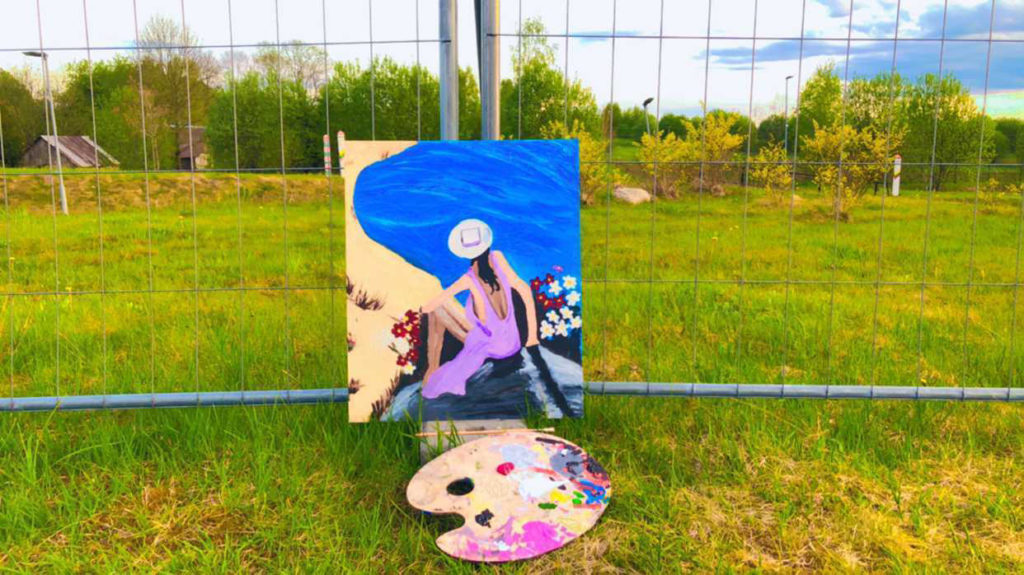
This confined space is nothing new to Anna, a 22-year-old originally from Iraq. She has been living in a container like this with three other Iraqi women for almost a year. Her only new experience today is our visit.
“I know. They are beautiful. So sad that so many Da Vincis need to be imprisoned here,” I reply to the security guard’s comment about Anna’s paintings. He nods while he seems to be trying to look for the right answer. Breaking the silence, he says: “It’s politics. It’s all about politics. I just work and follow instructions.”
After that, the security guard gives instructions to a young female soldier to bring Anna while he continues to look into some bags I brought containing frames, canvas, watercolors, brushes, and other donated materials collected by the Wall Group, an initiative that started in November 2021 to support the migrants coming to Lithuania.
Anna comes with a contagious smile and watery eyes. She doesn’t recall when was the last time she had received a visit from anyone. She has gone more than seven years without seeing her family, but today her unique paintings allow her to receive a personal visit, even when those visiting are complete strangers to her.
Though their artistic styles vary widely, the ability to connect to the outside world through art is something the detainees helped by the Wall Group share in common.
Helping those who made it through
When Ewa got involved with the initiative of Wall Group, she just wanted to support people coming through the Lithuanian-Belarusian border with humanitarian aid, food, and clothes, etc. But soon, the initiative became life-changing for the people living in these camps, who were offered not only food but found someone in the country who saw them as “good people”
Ewa, a 39 year-old Lithuanian woman with two young children, would sometimes stay overnight in “our base,” as she calls it. A place 30 km away from Vilnius, the capital city, where the organization stores its main resources to support asylum seekers. Throughout the night or during the day, with temperatures below zero, Ewa and a small group of volunteers would go to the Lithuanian borders to find people in the middle of their traumatic journeys after a ring on her phone, usually calls asking for food, water, or warm clothes.
As Ewa tells me, and the latest report from Amnesty International shows, many of the people, who mainly come from Middle Eastern and African countries, recount being verbally and physically abused, pushed back over the border multiple times by Lithuanian border guards using physical violence. This behavior was backed up by the government, which gave them the instruction to “turn migrants away by force if needed.”
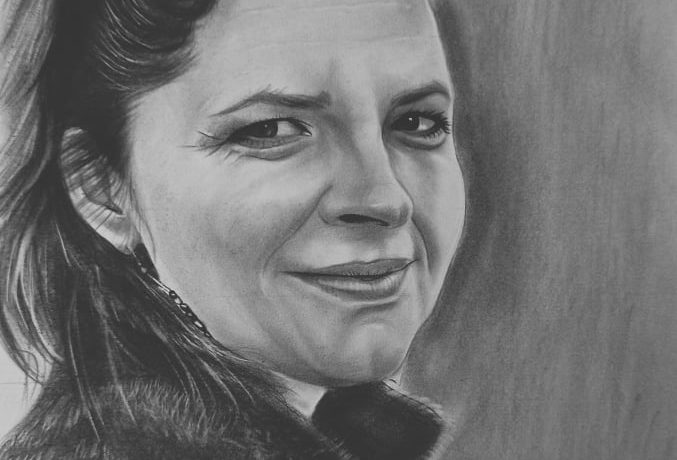
One day, Ewa noticed that many of the people seeking asylum were very talented. Ewa saw their amazing artwork, beautiful drawings, and paintings and decided to start posting them on Facebook. That was how this initiative to help specifically artists in detention in Lithuania got started.
Since then, her Facebook profile has turned into an online exhibition of their artwork. Her inbox on the same platform has become a help hotline for many other visual artists living in camps eager to paint, draw and show their work to the world while they are behind the fence.
“I also draw. Can I show you my paintings?” and similar requests Ewa, or “the mother of refugees,” as many of them call her, receives on a daily basis.
Drawing to remember
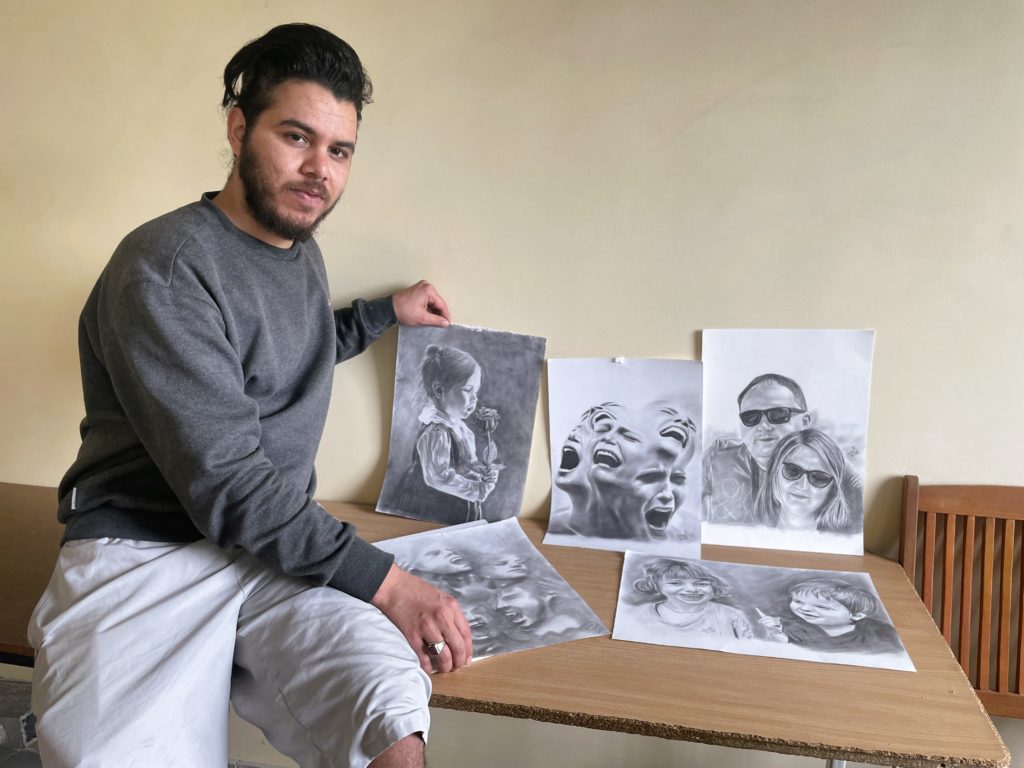
“I have wanted to make a drawing for you since we met,” Daniel tells me as we chat online. “But I have so many requests. I am very busy”, Daniel Español, as he likes to call himself, continues. His last name is an indication of his Spanish skills. In Iraq, he used to work as a translator for the North Atlantic Treaty Organization (NATO) in the Basmaya area located in Baghdad.
Daniel now spends hours drawing incredibly realistic pencil portraits. Steve Jobs, Pope John Paul II, and Dalia Grybauskaitė, the former President of Lithuania, are some of the familiar faces I can recognize as he shows me some photos of his work saved on his phone. But he doesn't only draw famous personalities; for Daniel, his art is also a way of loving those who are far away while he is detained in Kybartai.
Kybartai Foreigners Registration Center is a former prison the Lithuanian government converted into a “Foreigner Center” to accommodate thousands of migrants. However, the only change made was the name. It still looks and feels like a prison with barred windows, a high perimeter wall, and a small square with a single tree in the middle where its inhabitants can look at the sky.
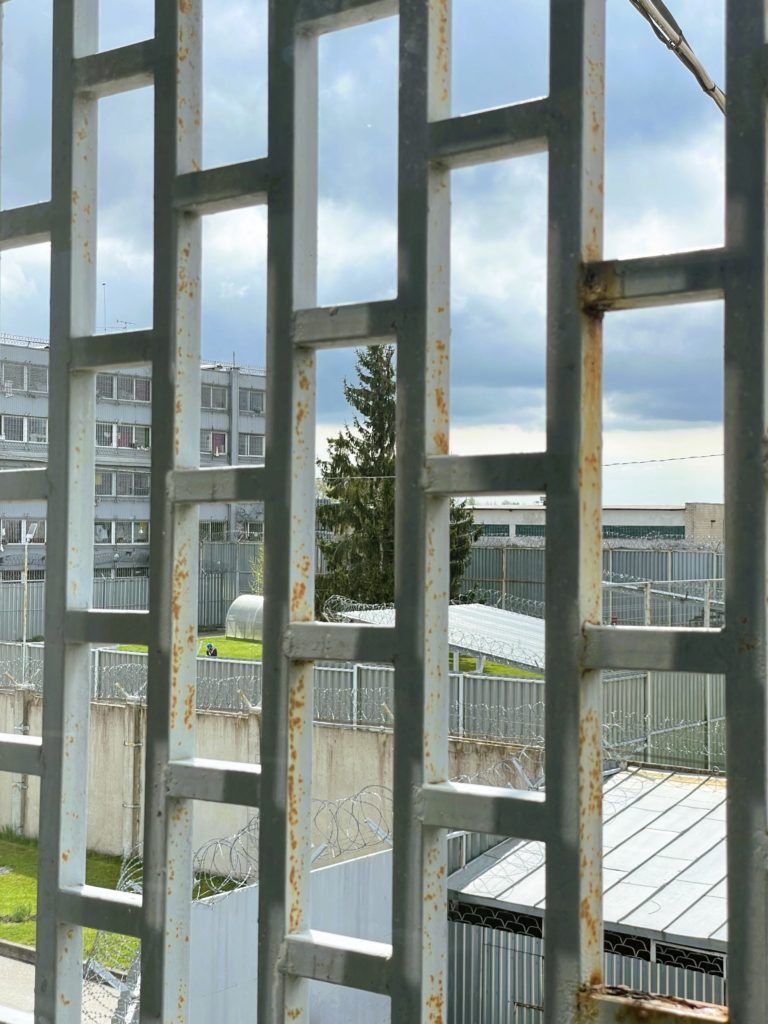
From here, Daniel draws his girlfriend every month. He now has accumulated 11 drawings from the 11 months he has been living on the border of Lithuania that he hangs on the pink wall in his cold room. “When I miss her eyes, I draw her eyes,” he says, smiling like he was actually looking at her.
Daniel’s work is striking, vivid, and intimate. It can call the attention of anyone passing by, including guards and kitchen workers who have many times requested Daniel to draw their kids, wives, friends, or even a portrait for themselves. “All for free,” he laughs. “Sometimes free, sometimes they pay,” he corrects himself.
Their clients not only come from the personnel working in the centers but also Lithuanian and Polish people have gotten in contact with these artists through the Wall Group and its volunteers, who publish their work across different social platforms. Depending on the piece, the price changes, but the compensation has been up to 100 EUR for a painting and 30 EUR for pencil portraits. They also receive donations that come from the goodwill of anyone who wants to support them. But money is the last reason many of these artists paint. Most of them donate their earned small resources to help other detained fellows or use them to buy food at some “markets” inside the camps.
"The only reason why I haven’t gone crazy in this prison is that I have paper and a pencil,"
Daniel, artist detained in Kybartai, one of the Lithuania's refugee camp.
In that sense, for these people making art is the only resource they have to feel alive, useful, and productive while in prison. As they tell me, it has also empowered them to believe in their talent and potential, especially after seeing their artwork displayed in exhibitions at universities, community, and cultural centers across the country. There was even a recent exhibition at the parliament of Lithuania, where some of the artists were allowed to attend. For most of them, this was the first time breathing fresh air outside the detention centers since they were detained.
The struggle to help
In order to tackle the lack of action from authorities and the administration of these refugee camps, independent organizations such as Wall Group try to find resources to keep bringing materials for asylum seekers to draw, paint and keep their minds active in creative ways. As they struggle to raise funds that might enable them to continue doing this important work, they have created crowdfunding and social media campaigns to raise awareness of the situation of asylum seekers in Lithuania. They also dream of developing a digital platform that could ease the way artist migrants create and sell their artwork over the borders that they can’t cross at the moment.
Wall Group has been in contact with at least 100 detained artists, but they have been able to support only around half of them due to lack of resources. Most support has come from their own pockets and the solidarity of their friends.
However, the lack of financial resources is not the only limitation this collective faces in continuing its work. As Ewa mentions, it is difficult to find volunteers in Lithuania, especially because of prejudices and the media narrative used in the country against migrants and asylum seekers. “People in Lithuania say we (volunteers from Wall Group) are criminals working against the country because we are helping migrants,” says Ewa.
“I also needed to overcome this fear. I went there and realized that these are good people, just like other people,” says Lukas, coordinator of the Jesuit youth program MAGIS in Lithuania, who volunteered for about six months in a refugee camp teaching English.
Wall Group works with around 15 committed volunteers supporting their mission. Even so, their work is making a change in the lives of many of the artists in detention, based on their testimonies. It is clear to them that there is a lot more to do to make a real change as they talk about their struggles and limitations.
“These initiatives are never a substitute for the work the government should be doing. We don’t have the scale to do as much as we want. We pay for everything, gas, child care… It is good as long as it is good, but when circumstances come we can’t sustain it”, says Lukas.
“Once I had forgotten my phone and one of the refugees ran to bring it back to me. They are not criminals”, says Lukas, as he thinks of the importance of breaking the stigmatization against these people.
There is a whole complex set of logistics to bring art to clients and also for the artists to receive compensation for their work.
"A chance to do good things"
“In this world, I can’t draw anything, but when I draw, I am in another world,” says Amir* from Iraq. Since he entered Lithuania, he has been transferred to three different camps. “This one [Kybartai] is paradise”, he says. For Amir, the treatment at this center is a “bit better” when compared with previous experiences. “They respect me and treat me better because they see my artistic work,” he adds.
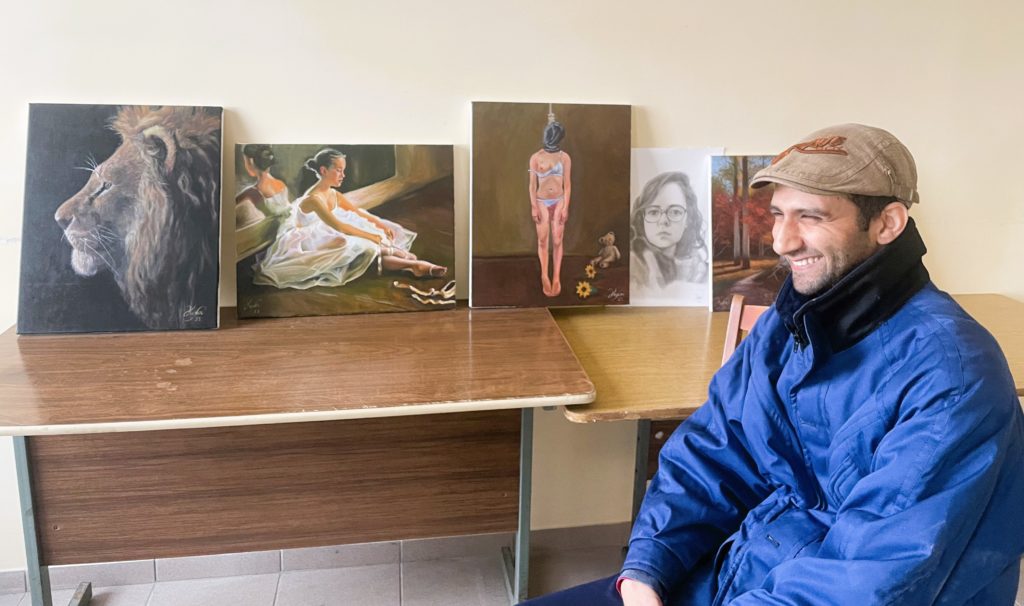
His new room has a small window, clean painted walls, and more space for his canvas and painting materials, where he usually spends at least six to seven hours per day. “I have nothing to do, so I can only paint,” the man says.
“Nothing to do” is the reality for most of the asylum seekers in Lithuania, where there is a lack of integration programs and access to education or other occupational activities for the more than 2000 people, 500 children among them, remaining in the country.
However, while there is “nothing to do,” many of them have decided to bring their skills and motivation to get the most out of this situation.
In that sense, they have created a network of community support for each other. For example, Carla, from Cameroon, teaches English, French, and Russian for up to eight hours every day with three different lesson groups depending on the skills of her students, tells the young nursing student who stopped her studies due to the war in her home country.
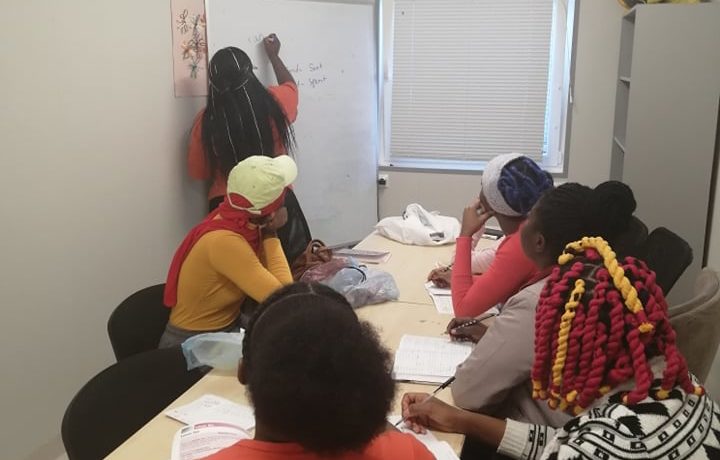
Julia (25 years old), who loves painting and singing, says that she is using this time to learn other languages. While her mother language is Kurdish, she can also speak Arabic, English, and Korean. She is also now teaching herself Lithuanian.
Katherin (19 years old) from Iran is old enough to know that, as she says: “every person has one chance in life, and you need to take that chance to do good things.” Since she arrived in Lithuania, Katherin has spent her time trying to improve her drawing skills and also developed new hobbies, as she loves gardening.
Luis* from Cameroon (21 years old) is called “The Bible Refugee,” as he has spent the last year illustrating and writing in French the most popular stories from this book. The Ark of Noah and Adam and Eve are some of the stories he has drawn from the Old Testament. He is also drawing the New Testament.
At 33, Amir expresses his desire to go to school again. This time not to study Math, though. “I want to go to Art School,” the math teacher says as he tries to overcome the uncertainty of not knowing what his legal situation is by making plans. After all, dreams do not have an expiration date.
“I want to stay in Lithuania. I don’t want to go to Germany or other European countries”, he adds, as he thinks out loud about his future and what he would like to do if the Lithuanian government were to grant him asylum.
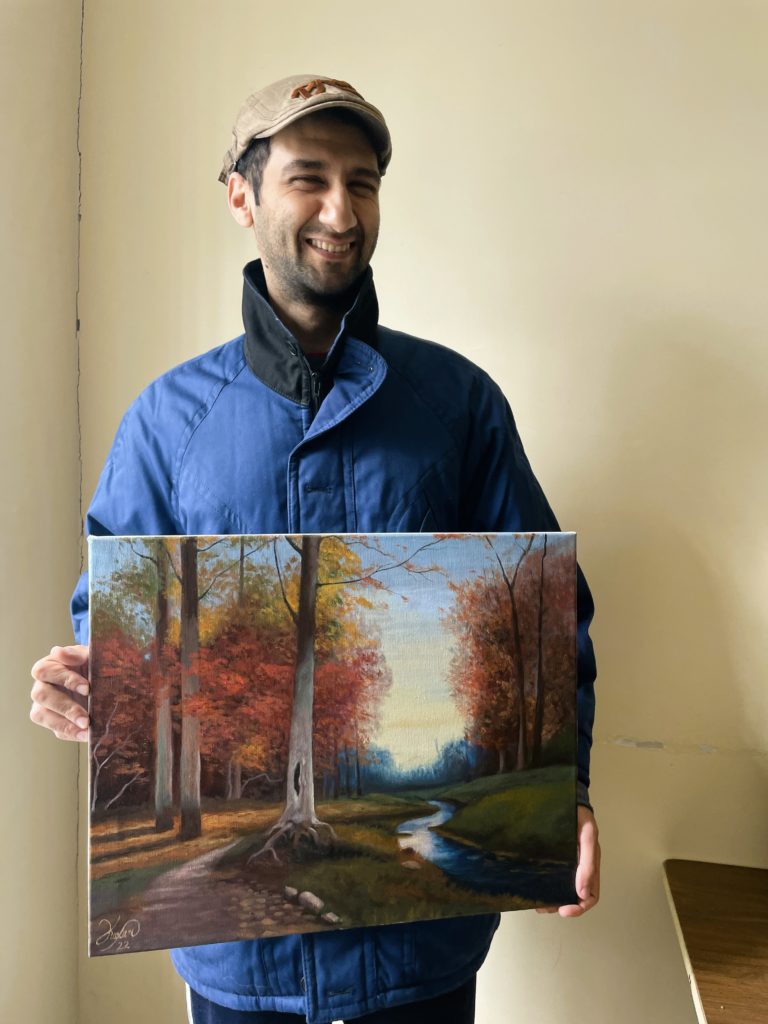
Lukaschenko's threat
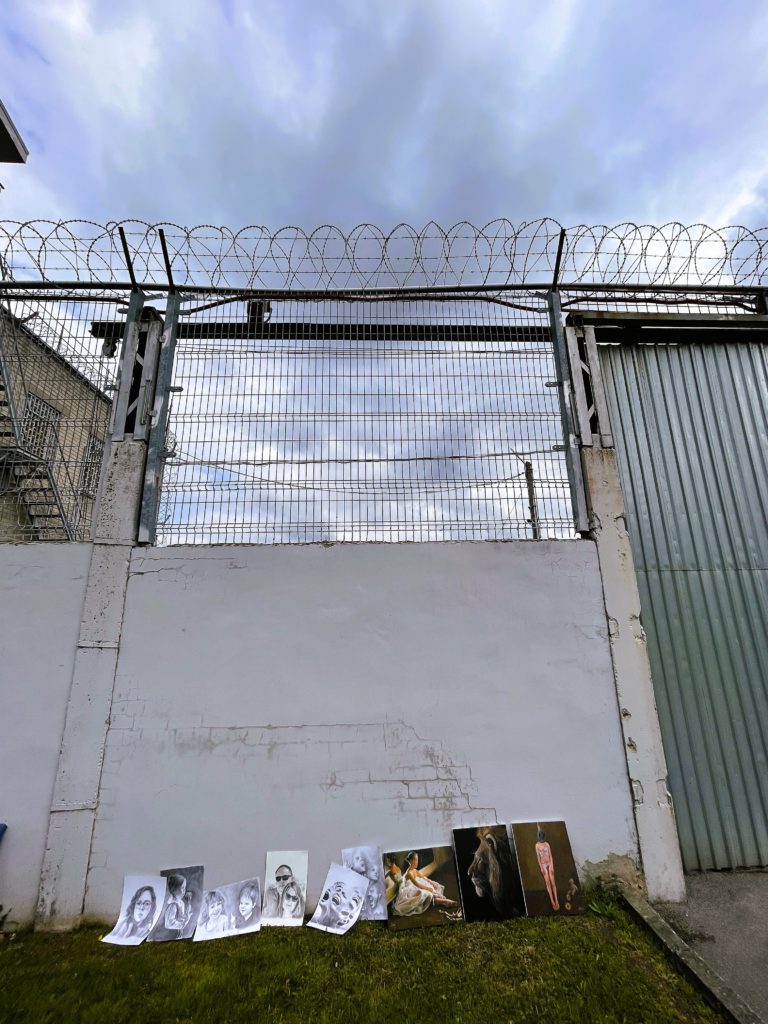
How did these artists end up detained in Lithuania for almost a year in the first place?
In June 2021 over 4000 people attempted to cross the forest that divides Lithuania and Belarus, most of them below 30 years old from Syria, Afghanistan, Iraq, and multiple African countries. They were apprehended by Lithuanian State Border Guards and detained in Foreigner’s Centers, not permitted to leave.
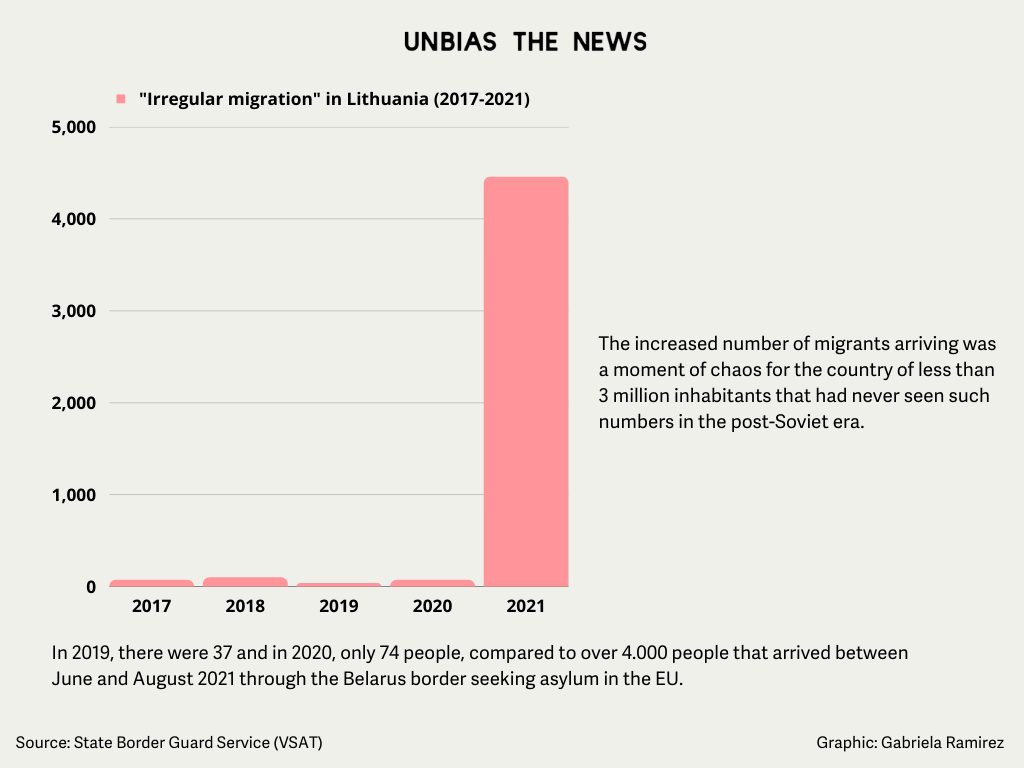
This increase occurred suddenly after the contested leader of Belarus, Alexander Lukashenko, threatened to flood Lithuania “with migrants and drugs,” in May 2021.
Because of Lukashenko’s words, the EU viewed the border crossings as an act of aggression. “This is not a migration issue, but part of the aggression of Lukashenko toward Poland, Lithuania, and Latvia, with the aim to destabilize the EU,” EU Commissioner for Home Affairs Ylva Johannssen told the New York Times. EU Commission Vice President Margaritis Schinas used the same war-like language, posting to Twitter, “When one of us is attacked, we are all attacked.”
With support from the EU, Lithuania detained these migrants at first for six months. After the first six months, the limbo continued, and the Lithuanian government extended the detention for six months more. In the meantime, Lithuania has worked on creating a 550 kilometer-long barbed wire fence in the 680-kilometer border territory with Belarus.
“The European Union forced Lithuania to put us in prison to save Germany and Europe,” one of the asylum seekers comments as he tries to make sense of the political game that has kept them behind the fences for almost a year.
“As a prisoner, at least you know how long you will be in prison, but here we have no idea. We know nothing,” says Daniel Español.
Daniel has been waiting for a year now for the country to process his request for asylum. Like Daniel, thousands of them are waiting. But rather than working on their applications, the government has tried to convince them to go back “voluntarily” by offering up to 1.000 EUR. Ewa also says in many cases verbal abuse, torture, sexual humiliation, and family separations have been involved in incentivizing the “voluntary decision” of these people to be sent back to their countries.
Uncertain Future
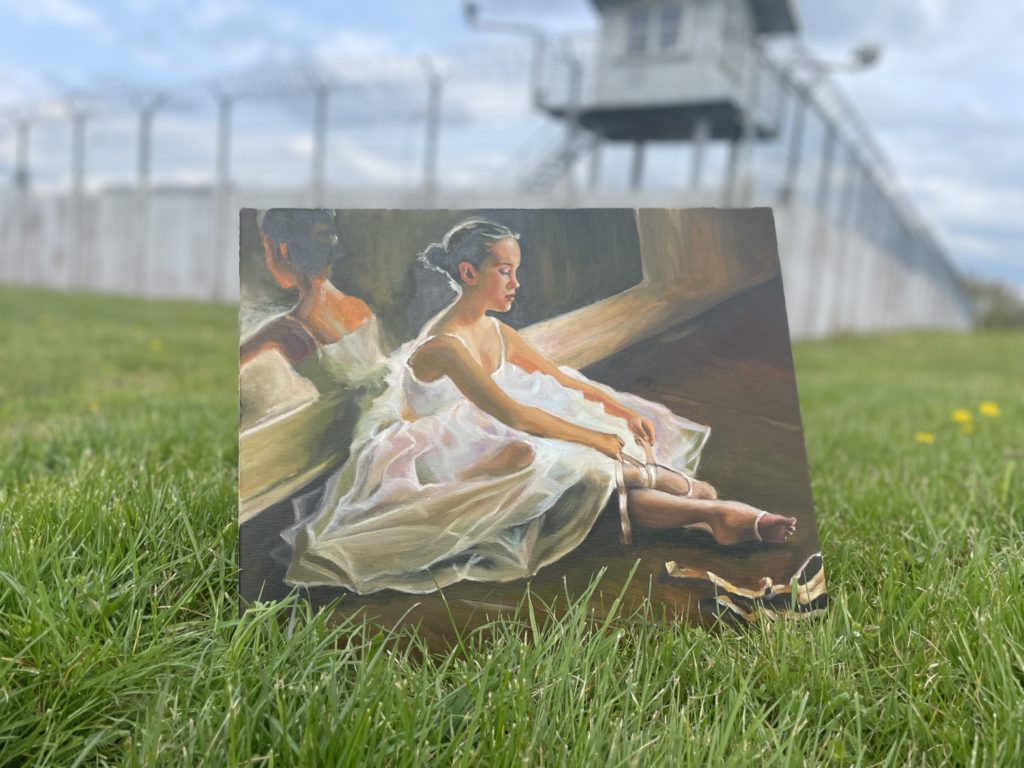
“The worst part is the uncertainty…we would like to know what the future is for us, or do they pretend to have us in prison forever?” Beatriz told me during a conversation over the phone. Minister of Interior, Agnė Bilotaitė, answered that question, telling reporters, “Our decision is that we will not propose extending the existing movement restrictions. That’s the plan,” she said after rumors of the possible extension of the detention to 18 months.
However, as Goda Jurevičiūtė, Advisor at the Human Rights Division of Seimas Ombudspersons, Office, told Unbias The News in an interview: “The Government decided not to extend the detention after 12 months, but, of course, there are nuances.”
One of them is that the government would grant them back their right to move freely within the country while they wait for their legal procedures. However, they are not allowed to work, and they don’t have a residence permit. Asylum seekers have started to receive a so-called “green pass.” With such a pass, some of them would be allowed to go out for 24 or 72 hours with a previous request.
However, as this new Lithuanian strategy to handle the situation has started to be implemented, there are already signs of failure or success, depending on the perspective you see it. According to a report from LRT, the Lithuanian public broadcaster, 19 migrants who were allowed to move freely never came back to the center in Kybartai.
Just as the minister Bilotaitė speculates: “These people will probably leave for the countries they originally planned to go to as soon as they are free to leave their accommodation.” “This will probably result in a situation where we will no longer have most of these people in Lithuania. We cannot keep these people indefinitely,” she said, but her fellow Deputy Interior Minister, Vitalij Dmitrijev, speculates, “If these people are detained in Poland or Germany, they will be returned to us in any case.”
Emergency as an excuse
In a report from June 27th, Amnesty International says Lithuania has “arbitrarily detained thousands of people in militarized centers where they were held in inhumane conditions, tortured and otherwise ill-treated.”
To this report, the Minister of Interior of Lithuania responded: “The context of the situation has not been taken into account because these are not just migration processes and these are not war refugees fleeing from war,” she said. The 1951 Refugee Convention, to which Lithuania is a signatory, does not however protect people fleeing war, but individuals seeking protection on the basis of persecution because of their race, religion, ethnicity or other bases.
“It is a fundamental human right for people to seek asylum, and this also applies in extraordinary situations or in times of emergency. We call on Lithuania to live up to its international obligations by providing access for asylum-seekers and by ensuring proper reception conditions and fair and efficient asylum procedures.”
Renata Kules, UNHCR spokesperson said in an interview for Unbias The News.
The Minister of Interior, Agnė Bilotaitė, referred to the “state of emergency” declared by Lithuania last summer when people started to come: “There was no available infrastructure. All of it had to be created. It was not easy to find places.” However, in a recent tweet, the minister also touted the country’s generosity in offering temporary protection to Ukrainians. “We have already welcomed almost 48 thousand Ukrainians, which is equal to 1.7 % of the country’s population. This figure is 3.4 times higher than the EU average’, the politician wrote.
“While Lithuania has rightly extended a warm welcome to tens of thousands of people fleeing Ukraine, the experience of the detainees we spoke with could not be more different. This raises serious concerns about institutional racism embedded within Lithuania’s migration system."
Amnesty International Report, "Lithuania: Forced out or locked up – Refugees and migrants abused and abandoned"
48.000 of Ukrainian refugees have been received with open arms in Lithuania after seven months that Lithuania declared a state of emergency and detained 4.000 from the Middle East and African countries due to “lack of infrastructure” or, as Amnesty International calls it in its report, “institutional racism.”
In late June, the European Court of Justice ruled that Lithuania’s automatic detention of migrants and refugees for extended time violates EU law and cannot be justified by emergency circumstances.
Some people who feel for us
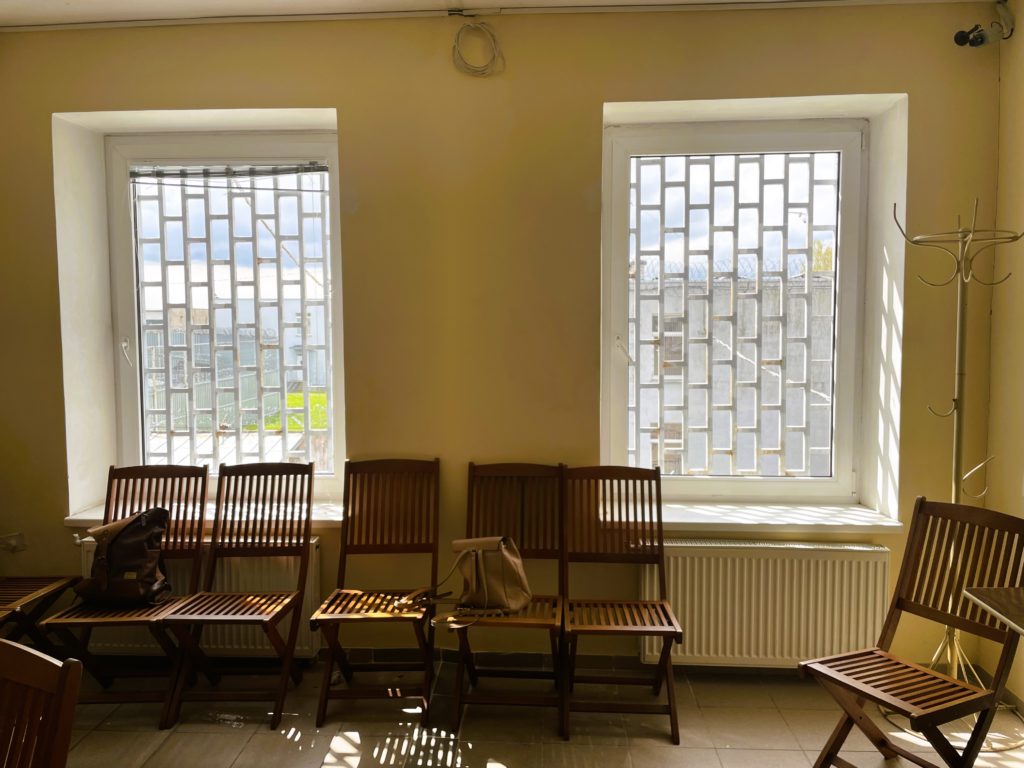
On the day of our visit to Kybartay, Ewa mentions: “today we are lucky.” In this context, “being lucky” means that we were allowed to see four refugees on the same appointment, there was not a guard supervising the visit, and the appointment was not cut short as usually happens. However, according to Ewa, this was only “luck” and an exception to what most of the volunteers of the initiative have experienced over the last months taking care of some of these people.
Most of the time, visits are cut short, volunteers are mistreated by state guards, and the administration of these centers makes the procedure of arranging visits a nightmare. When visits are finally arranged, the appointments are sorted in a way that makes it harder to meet many of these people, with visits spread randomly hours apart.
“The restrictions to visit migrants in the camp are very strict. So you need a very good pretext to be able to see them,” says Lila, a young volunteer from France who collaborates with the initiative. As she mentions, people in detention are allowed to receive visits from relatives, some of them already living in other countries in Western Europe, such as Germany or France. Yet, traveling to Lithuania may not be possible for their relatives who are also undergoing legal processes.
In that sense, the solidarity of volunteers like Lila is the only thing these artists can hope for not only to continue painting but also to “feel as human beings,” as some of them usually write after they have met with these volunteers. “I am very happy to get to know you. Thank you because today I felt like a human being. I felt that there are some people who feel for us,” writes one.
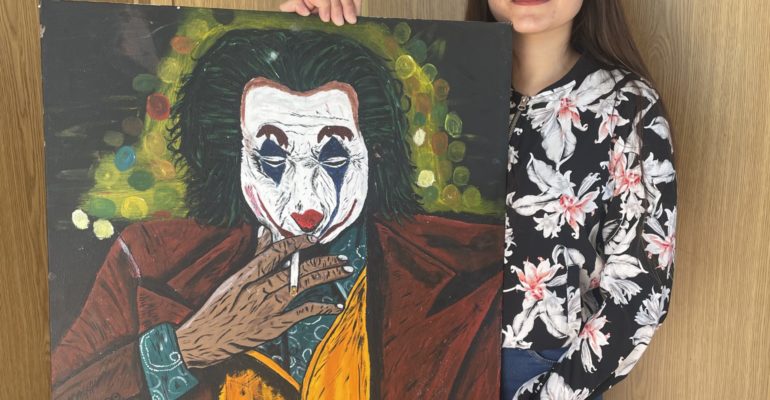
“He is bad, like me,” the border guard remarks as he laughs when commenting about one of Annas’ paintings of The Joker, the famous Clown Prince of Crime, an insane criminal mastermind character.
For now, the artists await a response from authorities that reflects the rights they have to seek refuge in this country. “Bad” border guards joke about it. For many of them, the question is, when this heavy rain will stop, even when the terrible weather has become the main inspiration for these creative people to make art behind a fence after a year of being imprisoned in Lithuania.
*Names have been changed
About the author: Gabriela Ramirez is a Venezuelan multimedia journalist researching the intersections of journalism, innovation, and product strategy. At Unbias The News, she develops social media and content strategies to tell stories audiences engage with. She holds a Master in Interactive Journalism.
Please consider a donation to support the work of our feminist, anti-racist newsroom. We create a space for journalists facing structural barriers, working towards a more equitable, inclusive world of journalism. Join our mission today!

